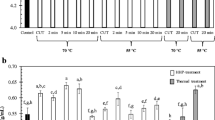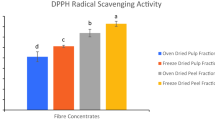Abstract
This study examined the effects of high hydrostatic pressure (HHP) processing on dietary fiber, cell wall sugars, cell wall-modifying enzymes, and techno-functional properties of astringent and non-astringent persimmon flesh. The fruits were subjected to 200 and 400 MPa for 1, 3, and 6 min, at 25 °C. Dietary fiber and alcohol insoluble residue (AIR) were affected significantly (p ≤ 0.05). Soluble fraction of fiber (SDF) decreased, and AIR content increased up to 46% after application of high pressure. HHP reduced total sugar content of AIRs and promoted changes in the contribution of uronic acids (UA) and glucose, obtaining pectin-enriched materials (from 45 to 61% UA) in astringent persimmons treated by pressure. Pectinmethylesterase (PME) activity increased independently of the astringency level of persimmons (from 1.7- to 2.0-fold), while polygalacturonase (PG) activity was highly dependent on pressure and time conditions of HHP treatments. The application of HHP enhanced techno-functional properties of persimmon AIRs. Great water-absorption (21–31 mL/g AIR) and oil-holding (10–14 mL/g AIR) capacities were obtained for HHP-treated astringent and non-astringent persimmons, respectively, which showed the potential of HHP technology to add value to persimmons.



Similar content being viewed by others
References
Alonso, J., Howell, N., & Canet, W. (1997). Purification and characterisation of two pectinmethylesterase from persimmon (Diospyros kaki). Journal of the Science of Food & Agriculture, 75, 352–358.
AOAC. (1995). AOAC Official Method 991.43. Total, soluble, and insoluble dietary fibre in foods. Official Methods of Analysis, 32, 7–9.
Basanta, M. F., Plá, M. F. E., Raffo, M. D., Stortz, C. A., & Rojas, A. M. (2014). Cherry fibers isolated from harvest residues as valuable dietary fiber and functional food ingredients. Journal of Food Engineering, 126, 149–155.
Bchir, B., Rabetafika, H. N., Paquot, M., & Blecker, C. (2014). Effect of pear, apple and date fibres from cooked fruit by-products on dough performance and bread quality. Food & Bioprocess Technology, 7, 1114–1127.
Benítez, V., Cantera, S., Aguilera, Y., Mollá, E., Esteban, R. M., Díaz, M. F., & Martín-Cabrejas, M. A. (2013). Impact of germination on starch, dietary fiber and physicochemical properties in non-conventional legumes. Food Research International, 50, 64–69.
Bodelón, O. G., Avizcuri, J.-M., Fernández-Zurbano, P., Dizy, M., & Préstamo, G. (2013). Pressurization and cold storage of strawberry purée: colour, anthocyanins, ascorbic acid and pectin methylesterase. LWT - Food Science and Technology, 52(2), 123–130.
Brownlee, I. A. (2011). The physiological roles of dietary fibre. Food Hydrocolloids, 25, 238–250.
Elizondo-Montemayor, L., Hernández-Brenes, C., Ramos-Parra, P. A., Moreno-Sánchez, D., Nieblas, B., Rosas-Pérez, A. M., & Lamadrid-Zertuche, A. C. (2015). High hydrostatic pressure processing reduces the glycemic index of fresh mango puree in healthy subjects. Food & Function, 6, 1352–1360.
Elleuch, M., Bedigian, D., Roiseux, O., Besbes, S., Blecker, C., & Attia, H. (2011). Dietary fibre and fibre-rich by-products of food processing: characterisation, technological functionality and commercial applications: a review. Food Chemistry, 124, 411–421.
FAOSTAT (2016). Food and Agriculture Organization of the United Nations. Statistics Division. Production. http://faostat.fao.org/. Accessed 15 July 2016.
Garau, M. C., Simal, S., Rosselló, C., & Femenia, A. (2007). Effect of air-drying temperature on physico-chemical properties of dietary fibre and antioxidant capacity of orange (Citrus aurantium v. Canoneta) by-products. Food Chemistry, 104(3), 1014–1024.
Gross, K. C. (1982). A rapid and sensitive spectrophotometric method for assaying polygalacturonase using 2-cyanoacetamide. Hortscience, 17, 933–934.
Gupta, P., & Premavalli, K. S. (2010). Effect of particle size reduction on physicochemical properties of ashground (Benincasa hispida) and radish (Raphanus sativus) fibres. International Journal of Food Science & Nutrition, 61(1), 18–28.
Hauner, H., Bechthold, A., Boeing, H., Brönstrup, A., Buyken, A., Leschik-Bonnet, E., et al. (2012). Evidence-based guideline of the German nutrition society: carbohydrate intake and prevention of nutrition-related diseases. Annals of Nutrition & Metabolism, 60(1), 1–58.
Hernández-Carrión, M., Hernando, I., & Quiles, A. (2014a). High hydrostatic pressure treatment as an alternative to pasteurization to maintain bioactive compound content and texture in red sweet pepper. Innovative Food Science & Emerging Technologies, 26, 76–85.
Hernández-Carrión, M., Vázquez-Gutiérrez, J. L., Hernando, I., & Quiles, A. (2014b). Impact of high hydrostatic pressure and pasteurization on the structure and the extractability of bioactive compounds of persimmon “Rojo Brillante”. Journal of Food Science, 79(1), C32–C38.
Hernández-Carrión, M., Tárrega, A., Hernando, I., Fiszman, S. M., & Quiles, A. (2014c). High hydrostatic pressure treatment provides persimmon good characteristics to formulate milk-based beverages with enhanced functionality. Food & Function, 5, 1250–1260.
Hurtado, A., Picouet, P., Jofré, A., Guàrdia, M. D., Ros, J. M., & Bañón, S. (2015). Application of high pressure processing for obtaining “fresh-like” fruit smoothies. Food & Bioprocess Technology, 8, 2470–2482.
Jaime, L., Mollá, E., Fernández, A., Martín-Cabrejas, M. A., López-Andréu, F. J., & Esteban, R. M. (2002). Structural carbohydrate differences and potential source of dietary fiber of onion (Allium cepa L.) tissues. Journal of Agricultural & Food Chemistry, 50, 122–128.
Jolie, R. P., Duvetter, T., Van Loey, A. M., & Hendrickx, M. E. (2010). Pectin methylesterase and its proteinaceous inhibitor: a review. Carbohydrate Research, 345(18), 2583–2595.
Koubala, B. B., Kansci, G., Garnier, C., Thibault, J.-F., & Ralet, M.-C. (2013). Physicochemical properties of dietary fibres prepared from ambarella (Spondias cytherea) and mango (Mangifera indica) peels. Food & Bioprocess Technology, 6, 591–597.
López-Marcos, M. C., Bailina, C., Viuda-Martos, M., Pérez-Alvarez, J. A., & Fernández-López, J. (2015). Properties of dietary fibers from agroindustrial coproducts as source for fiber-enriched foods. Food & Bioprocess Technology, 8, 2400–2408.
Martín-Cabrejas, M. A., Waldron, K. W., Selvendran, R. R., Parker, M. L., & Moates, G. K. (1994). Ripening-related changes in the cell walls of Spanish pear (Pyrus communis). Physiologia Plantarum, 91, 671–679.
Mateos-Aparicio, I., Mateos-Peinado, C., & Rupérez, P. (2010). High hydrostatic pressure improves the functionality of dietary fibre in okara by-product from soybean. Innovative Food Science & Emerging Technologies, 11(3), 445–450.
Menezes, E. W., Giuntini, E. B., Dan, M. C. T., Sardá, F. A. H., & Lajolo, F. M. (2013). Codex dietary fibre definition – justification for inclusion of carbohydrates from 3 to 9 degrees of polymerisation. Food Chemistry, 140, 581–585.
Mir-Marqués, A., Domingo, A., Cervera, M. L., & Guardia, M. (2015). Mineral profile of kaki fruits (Diospyros kaki L.). Food Chemistry, 172, 291–297.
Mújica-Paz, H., Valdez-Fragoso, A., Samson, C. T., Welti-Chanes, J., & Torres, J. A. (2011). High-pressure processing technologies for the pasteurization and sterilization of foods. Food & Bioprocess Technology, 4, 969–985.
Niba, L. (2012). Progress in fiber-enriched foods. Food Technology, 66, 36–43.
Norton, T., & Sun, D.-W. (2008). Recent advances in the use of high pressure as an effective processing technique in the food industry. Food & Bioprocess Technology, 1, 2–34.
Núñez-Mancilla, Y., Vega-Gálvez, A., Pérez-Won, M., Zura, L., García-Segovia, P., & Di Scala, K. (2014). Effect of osmotic dehydration under high hydrostatic pressure on microstructure, functional properties and bioactive compounds of strawberry (Fragaria vesca). Food & Bioprocess Technology, 7, 516–524.
Önal, Y., Schimpf, S., & Claus, P. (2004). Structure sensitivity and kinetics of d-glucose oxidation to d-gluconic acid over carbon-supported gold catalysts. Journal of Catalysis, 223(1), 122–133.
Polydera, A. C., Galanou, E., Stoforos, N. G., & Taoukis, P. S. (2004). Inactivation kinetics of pectin methylesterase of greek Navel orange juice as a function of high hydrostatic pressure and temperature process conditions. Journal of Food Engineering, 62(3), 291–298.
Robertson, J. A., Monredon, F. D., Dysseler, P., Guillon, F., Amado, R., & Thibault, J. (2000). Hydration properties of dietary fibre and resistant starch: a European collaborative study. LWT - Food Science and Technology, 33, 72–79.
Rodrigo, D., Cortés, C., Clynen, E., Schoofs, L., Van Loey, A., & Hendrickx, M. (2006). Thermal and high-pressure stability of purified polygalacturonase and pectinmethylesterase from four different tomato processing varieties. Food Research International, 39(4), 440–448.
Salvador, A., Arnal, L., Besada, C., Larrea, V., Quiles, A., & Pérez-Munuera, I. (2007). Physiological and structural changes during ripening and deastringency treatment of persimmon fruit cv. ‘Rojo Brillante’. Postharvest Biology & Technology, 46(2), 181–188.
Salvador, A., Arnal, L., Besada, C., Larrea, V., Hernando, I., & Pérez-Munuera, I. (2008). Reduced effectiveness of the treatment for removing astringency in persimmon fruit when stored at 15 °C: physiological and microstructural study. Postharvest Biology & Technology, 49(3), 340–347.
Sila, D. N., Smout, C., Satara, Y., Truong, V., Van Loey, A., & Hendrickx, M. (2007). Combined thermal and high pressure effect on carrot pectinmethylesterase stability and catalytic activity. Journal of Food Engineering, 78, 755–764.
Van Linden, V., Sila, D. N., Duvetter, T., Baerdemaeker, J., & Hendrickx, M. (2008). Effect of mechanical impact-bruising on polygalacturonase and pectinmethylesterase activity and pectic cell wall components in tomato fruit. Postharvest Biology & Technology, 47, 98–106.
Vázquez-Gutiérrez, J. L., Quiles, A., Hernando, I., & Pérez-Munuera, I. (2011). Changes in the microstructure and location of some bioactive compounds in persimmons treated by high hydrostatic pressure. Postharvest Biology & Technology, 61(2–3), 137–144.
Vázquez-Gutiérrez, J. L., Hernández-Carrión, M., Quiles, A., Hernando, I., & Pérez-Munuera, I. (2012). Impact of high hydrostatic pressures on the structure, diffusion of soluble compounds and textural properties of persimmon ‘Rojo Brillante’. Food Research International, 47(2), 218–222.
Verlent, I., Hendrickx, M., Verbeyst, L., & Van Loey, A. (2007). Effect of temperature and pressure on the combined action of purified tomato pectinmethylesterase and polygalacturonase in presence of pectin. Enzyme & Microbial Technology, 40(5), 1141–1146.
Wennberg, M., & Nyman, M. (2004). On the possibility of using high pressure treatment to modify physico-chemical properties of dietary fibre in white cabbage (Brassica oleracea var. capitata). Innovative Food Science & Emerging Technologies, 5(2), 171–177.
Acknowledgements
The authors gratefully acknowledge the financial support of Spanish Ministry of Science and Innovation through project AGL2008-04798-C02-01/ALI, and “Agrupación Nacional de Exportación de Cooperativas Citrícolas” (ANECOOP) for providing the persimmon samples. Rodríguez-Garayar is also grateful to Department of Education, Universities and Research of the Basque Government for the FPI fellowship awarded.
Author information
Authors and Affiliations
Corresponding author
Electronic Supplementary Material
ESM 1
(PDF 214 kb)
Rights and permissions
About this article
Cite this article
Rodríguez-Garayar, M., Martín-Cabrejas, M.A. & Esteban, R.M. High Hydrostatic Pressure in Astringent and Non-Astringent Persimmons to Obtain Fiber-Enriched Ingredients with Improved Functionality. Food Bioprocess Technol 10, 854–865 (2017). https://doi.org/10.1007/s11947-017-1870-y
Received:
Accepted:
Published:
Issue Date:
DOI: https://doi.org/10.1007/s11947-017-1870-y




